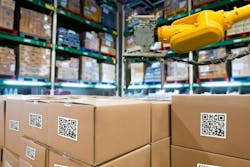What Sustainability Means for Manufacturers in 2022
Gartner’s findings, that 85% of investors regard environmental sustainability goals (ESG) as being key to their investments, suggest it will be. Here, Claudia Jarrett, US country manager at automation parts supplier EU Automation, explores how manufacturers can use technologies like artificial intelligence (AI) and the Industrial Internet of Things (IIoT) to achieve success through sustainability.
Sustainability remains something of a paradox for manufacturers in 2022. On the one hand, they are expected to deliver products around the world at higher speeds while minimizing costs. On the other, sustainability is no longer just a boardroom concern. Manufacturers face growing scrutiny from governments, increasingly aware consumers, and investors.
Yet, at the same time, the World Economic Forum (WEF) reports that manufacturing is responsible for 23% of carbon emissions in the United States. There’s clearly room for improvement and demand for it. But how can manufacturers achieve better sustainability while balancing so many demands? Digitalization holds the answer.
Circular Economy
According to PwC’s Going Circular report, “the circular economy is about rethinking everything, including business models themselves so that we can reduce consumption.” That includes reducing the number of raw materials from which products are made, reducing waste, and recycling and reusing resources as much as possible.
These goals spell a fundamental change in approach for manufacturers, away from today’s linear take-make-dispose model. Through the linear approach, products are made from raw materials extracted from resource-rich countries, then used to create products and excessive waste, before being transported to manufacturers to be further processed. Instead, a circular approach is needed. This is where digitalization will prove crucial, in part by making it possible to use real-time data about the location, condition, and availability of materials or products.
One example of a circular economy project is the “buy-back” program launched by Sandvik Coromant, the machine tool specialist. Through the program, customers can return their used products to Sandvik Coromant, which arranges the delivery before recycling them to reclaim key materials such as tungsten and other rare precious metals. Here, IoT devices like sensors are used to scan the returned tools. That includes a complete X-ray fluorescence analysis, which determines the metallurgical makeup of the returned tools before they are crushed into carbide powder from which new tools are made.
Not only is digitalization key to the traceability of materials in this example, but also to optimally reusing and recycling these materials. With processes like these, Sandvik Coromant’s parent company, Sandvik Group, hopes to become more than 90% circular by 2030.
Supply Chain Disruptions
Digitalization helps manufacturers gain real-time insights into the sourcing, movement, and delivery of products or materials. This will prove crucial to supply chain management, which will be a major issue for manufacturers in 2022.
Supply chain disruptions could once be blamed on work-from-home rulings and border closures necessitated by the COVID-19 pandemic. But today, extreme weather is emerging as a troubling factor. According to the National Oceanic and Atmospheric Administration (NOAA), 2016 to 2020 saw an average of 16.2 disasters per year that cost $120 billion annually. These figures were more than double the seven disasters recorded in previous years, 1980 to 2020, with a smaller annual cost of $45 billion.
Extreme weather affects supply chains in all kinds of ways, from preventing employees from getting to work, to widespread damage to critical infrastructure and the blocking of normal supply routes. Indeed, McKinsey predicts that “The probability of a hurricane of sufficient intensity to disrupt semiconductor supply chains may grow two to four times by 2040.”
McKinsey’s report, Could climate become the weak link in your supply chain?, concludes that “Industry 4.0 technologies could help support companies in achieving resilience as well as efficiency; for example, through improving transparency in supply chains, and in some cases, potentially changing the economics of production.” One example is Apple, which has pledged to cut emissions from its supply chain to net-zero by 2030 by reviewing its supply chain partners and the emissions they generate. Analysis through AI, data analytics, and sensors can support such reviews and help managers to spot patterns, anticipate purchasing demands, and better manage their inventories.
For example, according to PwC’s Digital Factories 2020 report, Nokia has incorporated lean management and data analytics across its global supply chain. On the shop floor, this includes wearable technologies for operators, robots, and gesture-based equipment controls. Nokia says it has improved manufacturing processes and increased operational stability through digitalization. With other benefits of Industry 4.0 like predictive maintenance, digitalized supply chains like Nokia’s can also be better prepared against disruptions, including those wrought by nature.
Hyperautomation
The “Great Resignation” continues across the US, an economic trend where employees voluntarily resigned from their jobs en masse beginning in early-2021. Reasons for the trend include a lack of protection for workers against COVID-19, wage stagnation, and rising costs of living. Anthony Klotz, an organizational psychologist and professor at Texas A&M University who first coined the term “Great Resignation”, believes the trend will slow down, that flexible working from home arrangements will become the norm, and that “managers could turn to automation and international candidates to fill open roles.”
But how will these developments work for manufacturers, who sometimes operate in siloed environments reliant on manual, time-consuming processes? While automation can increase the efficiency of existing processes, Gartner recommends hyperautomation as a key technology trend to look out for in 2022.
Hyperautomation brings together the use of IIoT technologies like AI, sensors, machine learning, and robotic process automation to automate as many business and IT processes as possible. The idea is that traditionally siloed manufacturing processes become faster, more efficient, and transparent. Rather than threatening human workers, hyperautomation can instead help them focus more on complex tasks. As reported by Forbes, “Hyperautomation technology and tools can empower you to advance sustainability by reducing operational costs and increasing revenues.”
Get Smart
Finally, smart factories and their capabilities will be crucial to manufacturers’ 2022 sustainability goals, including highly automated equipment that can self-adapt through machine learning for enhanced efficiency and flexibility. For example, intelligence derived from analysis and monitoring can help avoiding bottlenecks within production chains, while predictive analysis helps prevent last-minute failures and costly downtime emergencies.
This is where an automation spare parts supplier can lend a crucial hand. By helping manufacturers implement and retrofit Industry 4.0 technologies like smart sensors into existing plant setups, it can encourage them to embrace digitalized sustainability with less cost and fewer resources.
Better sustainability can also be achieved through big data, using petabytes of data to create digital twins and digital threads to help companies make better use of their resources. With these engineering simulations, manufacturers can continuously feed product performance data back to the design team and improve the quality and performance of new designs. This brings us back to PwC’s description of the circular economy as being about rethinking everything, including business models themselves, so that we can reduce consumption.
Smart factories give manufacturers boundless opportunities to adjust business models, improve operations and execute tasks faster and better than ever before. It can also help manufacturers embrace sustainability as the secret to success in times of turbulence.
To know more about the range of new, reconditioned, and obsolete parts available from EU Automation, visit www.euautomation.com.
About the Author

Claudia Jarrett
Head of Sales - The Americas, EU Automation
Claudia Jarrett is the Head of Sales for The Americas at EU Automation. EU Automation stocks and sells new, used, refurbished, and obsolete industrial automation spares. Its global network of preferred partner warehouses and wholly owned distribution centers enables it to offer a unique service within the automation industry, spanning the entire globe. It provides worldwide express delivery on all products meaning it can supply any part, to any destination, at very short notice.
